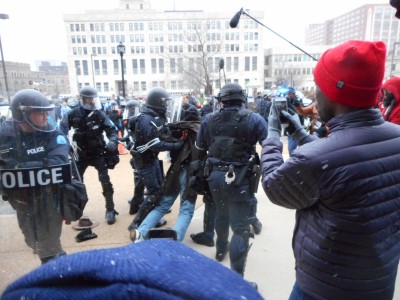The Eric Garner Legacy: Policing in Modern America

US police forces have been caught off guard by the ground swell of protests against their tactics, notably against minorities. The wearily grim figures of casualties among coloured communities is the primary cause. “Even if we didn’t know a Ferguson, or an Eric Garner or a Michael Brown… They were going on,” claimed Oprah Winfrey on TheGrio.com. The difference now is that such people have ceased to be nameless, assuming haunting forms in the protests that have swept various US cities. Banquo’s scolding ghost is here to stay.
The celebrity drive, spearheaded by such figures as Samuel L. Jackson, who has called upon citizens to protest the grand jury decision not to prosecute Daniel Pantaleo for his lethal chokehold of Eric Garner, is unnerving figures of authority. But for all this, defenders of the police can still be found.
Freshly elected Colorado congressman, Rep. Ken Buck, is one such individual. The United States, he would have people think, is besieged within by criminality – the sort that is going unreported by the terrified. “When was the last time you heard someone call 911 to report an intruder in their home and ask for a congressman to come and help them?” (Raw Story, Dec 15).
For Buck, the police are to be lionised rather than demonised. “Have we forgotten 9/11?” 23 New York City police officers and 37 Port Authority officers paid with their lives on that day. “As district attorney, I see that courage everyday from our law enforcement officers and know the price they pay.”
The New York Police Department itself, or at the very least, its technical side, revealed a form of that skewed courage when its Twitter account almost boastfully reproduced the words of Jack Nicholson’s character from A Few Good Men. The film examines the death of a US marine arising from a Code Red, a disciplinary action deemed illegal by the military, but used with lethal effect in the film. “You can’t handle the truth,” is certainly a statement that cuts both ways, and the tweet vanished in due course. So much for the antics of “motivational Monday”.
In the aftermath of Garner’s death, the NYPD message board, Thee Rant, was filled with fears about an ill-tempered populace.[1] “To all the active cops working, be alert. Put your cellphones away and watch each other’s backs.” An Officer Joe Bolton displayed a genuine degree of tone deafness to the sentiments, penning a message extolling the virtues of the jury system – and the exoneration process. “This is our jury system, and it’s not a lynch mob, it’s a democratic process” (BBC, Dec 4).
Similar points were found on the law enforcement website, PoliceOne.[2] One post features the old notion of individual will, which is a rather seedy way of suggesting that Garner brought it all upon himself, a fateful miscalculation. “Every now and then we win one. Horrible situation, man lost his life but like in the Ferguson case he controlled his own destiny.” Besides, he had pre-existing conditions (read, he was fat).
The Garner killing brought to mind another act of devastating brutality, in 2008, when a thinly built Carl Anne Gotbaum was fairly well smothered at Phoenix’s Sky Harbor airport by what were termed “corpulent cops”.[3] Whatever the build, the aggression will out, showing that police can be “equal-opportunity offenders” when they choose to be.[4]
A crucial feature of just policing is proportion, tempered by protocols of engagement that preserve, rather than destroy, their target. The militarisation of the police forces in the United States, who often resemble paramilitary entities armed to the teeth, reflects poorly on that balance. The first instinct is to arrest and apprehend – violently. A man illegally selling loose cigarettes on a street corner in Staten Island can pay with his life when brutally manhandled and choked.
The roots of this violent disposition reflect various operating rationales that revolutionised approaches to policing in New York in 1994. John Podhoretz, writing in Commentary (Dec 3), insists that the hallmarks of that revolution in approaching crime – one he claims was “correct” – involved treating the monstrous criminals, and the petty ones, as essentially one and the same. “Someone who jumped a subway turnstile, or someone who sold loose cigarettes, was more likely than not to be wanted for a more serious offence.”[5]
Major criminals, by virtue of this reasoning, get away – there is no fish small enough to fry by the law enforcement authorities. “This inspired strategy helped save New York City, and its adoption across the country helped save the nation from the most pressing domestic problem it faced from the 1960s to the 1990s.” While Podhoretz does admit that the treatment of Garner was inappropriately, and needlessly brutal, he also warns against the temptation to “defang cops”, something which is bound to invite “a return to trouble.” This, despite a supposedly dramatic fall in crime over the last two decades.
Such assumptions fly in the face of empirical rules, showing the bind that often happens when approaching criminality. Rather, it becomes a rule of supposition – if a person is committing a small offence, he is bound to be a really bad egg in need of breaking. It is precisely that supposition that is being challenged.
Dr. Binoy Kampmark was a Commonwealth Scholar at Selwyn College, Cambridge. He lectures at RMIT University, Melbourne. Email: [email protected]
Notes
[3] http://www.yourepeat.com/
[4] http://www.lewrockwell.com/
[5] http://www.commentarymagazine.

